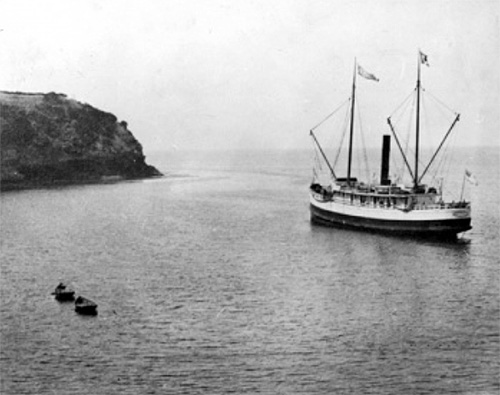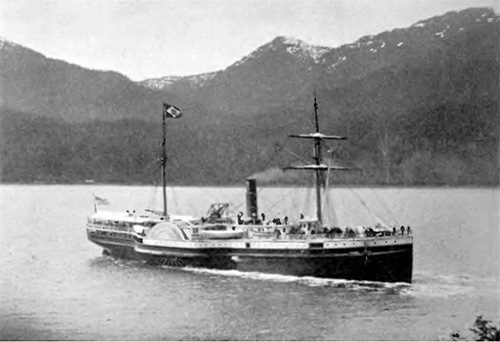Steamship Nizina |
It was barely a decade after the sinking of the Titanic and any time a ship hit an iceberg, it was still pretty big news, no matter how minor the scraping.
The 2373-ton SS Ketchikan had been part of the ASC fleet since 1916, according to information in the Alaska State Museum on the history of the Alaska Steamship Company. Originally the ship was built in Washington state in 1898 to take advantage of the sudden need for larger ships to handle Gold Rush era traffic to Alaska. It was called the Eureka until Alaska Steamship bought in and renamed it the Ketchikan. In 1926, the Ketchikan was renamed the Nizina and continued to serve until 1937, when she was scrapped.
And that's just about all we know about the SS Ketchikan. Fortunately, there is a much bigger story to tell about the Alaska Steamship Company, which was the primary way that goods and people came and went from Alaska for much of the early 20th Century.
After the United States purchased Alaska from Russia in 1867, the US government immediately began subsidizing monthly boat service into the newly acquired territory. Initially, ships traveled between Portland Oregon and Sitka and also made occasional stops in Wrangell, which was the only other “established” community in the region.
The primary service was to deliver the mail. Some of the ships also stopped at Fort Tongass, the brief military port post that was established on Tongass Island near the southern Alaska border with Canada.
An early visitor on one of those steamships was none other than William Henry Seward who visited the Alaska territory in 1869 on the ship, The Active, shortly after resigning as Secretary of State. Seward gave a speech in Sitka in which he promoted the idea of an eventual Alaskan statehood and he also visited Fort Tongass. Seward had been the prime mover in the US acquisition of Alaska and he made the trip north even though he was in poor health and would die not long after he returned from his Alaskan trip.
For the first two decades of Alaska service, the mail was handled by a revolving number of smaller ship lines. That changed in 1881 when the Pacific Coast Steamship Company of San Francisco took over the mail contract
The Pacific Coast Steamship Company brought several familiar steamers intro the region including the Eureka (a different ship than the one that became the SS Ketchikan), the Idaho and sidewheeler, the Ancon, which would famously sink near Loring in 1889.
With the development of the cannery at Loring in the early 1880s, the Ancon particularly became a familiar site in "Tongass Narrows" it approached Loring. Soon,"Tongass Narrows" or sometimes just "Tongass" was listed as an "as needed" stop on the PCSC schedule, even though there was no community yet in the area around a large salmon stream called - appropriately enough - Fish Creek. By 1887, the first cannery was operating in "Tongass Narrows" and ships were stopping to drop off supplies or passengers.
Steamship Ancon sometime between 1875 and 1889 |
Stories about visiting Alaska were also appearing in national magazines and newspapers and PCSC noted at the time that around 25 percent of its Alaska business was tourism related. By 1891, there was a wharf in the growing community of Ketchikan - still sometimes spelled Kichikan - and ships were stopping monthly in the community. Over the next decade, as Ketchikan grew, steam ship visits became more frequent, and businesses developed in the "downtown" area to cater to their needs. Early curio and jewelry stores popped up along the waterfront. Multiple steam ship companies entered the market including the newly formed Alaska Steamship Company. With weekly steam ship visits now the norm, the local tourism industry continued to grow. The Klondike Gold Rush of 1897-98 caused a boom in the steamship travel to Southeast Alaska also led to Canadian-based steamships entering the market.
In 1894, the Alaska Steamship Company was formed in Seattle. When the Klondike Gold Rush hit in 1897, the ASC expanded rapidly like just about all the other shipping lines on the West Coast, but unlike nearly all the others, it survived the Gold Rush. In fact, thrived.
While several of the other lines had trouble adjusting to the sudden market drop after the gold boom ended, the Alaska Steamship Company set up subsidiary operations to carry ore from other mines in Alaska, particularly those in the Copper River area. That led to mergers than gave the ASC more than enough financial muscle to survive any downturns.
The biggest merger was when the Alaska Syndicate bought controlling interest in the Alaska Steamship Company to service mines in the Wrangell Mountains. The Syndicate was owned by JP Morgan and Company and the Guggenheim family. Then there was another merger with the Northwest Steamship Company which also owned more than a dozen large canneries in the region. Soon there were 18 Alaska Steamship vessels plying the territorial waters from Ketchikan to Kotzebue. As other lines folded, Alaska Steamship developed a near monopoly on shipping to Alaska.
Large ACS steamships such as the Alaska, the Chena, the Baranof, the Denali, the Aleutian, and the Nenana were common sights in the Inside Passage, dominating both the passenger and the supply markets in Southeast.
In 1923, the Alaska Steamship Company inaugurated service of a 350-foot primarily passenger vessel, the Alaska II, on the Inside Passage run. While it wasn't the first passenger vessel on the run, it was the first ship to devote more space to passenger accommodations than the cargo storage. In 1932, she received new turbo electric powered engines and cut the travel time from Seattle to Ketchikan to under 40 hours for the first time.
The Great Depression of the early 1930s put a damper in pleasure travel and for those years most of the steamer traffic to Alaska was supplies and people coming and going from the Territory. But after World War II, there was another push to increase tourism in the Last Frontier.
Unfortunately other areas such as Europe and the Caribbean also saw tourism booms and Alaska didn't not keep up. That also spelled the end of steamship passenger service to the region.
Many of the ships that had been used for passenger and freight service to Alaska were requisitioned by the government during World War II and used heavily, and not always well maintained, according to the steam ship companies. In fact, that government control over the ships remained in place until 1949 further limiting the resumption of full steamship service to the Inside Passage.
Furthermore, the War had brought new airports to many Alaskan communities, including Ketchikan and Sitka. When faced with a choice between a three-day ocean voyage or a three-hour flight, those that could afford the planes took them, which further cut down on the "higher end" revenues the steamers relied on.
The Alaska Steamship Company continued to provide shipping services to the region, but soon began to lose out to the more economical barge companies. In 1954, it ended passenger service to Alaska.
The cargo hauling aspect of Alaska Steamship Company carried on until 1971, but eventually the cheaper use of barges spelled the end of the "steamship" days. Alaska Steamship Company shut down in January of 1971.
On the Web:
Columns by Dave Kiffer
Historical Feature Stories by Dave Kiffer
Dave Kiffer is a freelance
writer living in Ketchikan, Alaska. Dave Kiffer ©2022 Publication fee required. © |
Representations of fact and opinions in comments posted are solely those of the individual posters and do not represent the opinions of Sitnews.
Send a letter to the editor@sitnews.us
SitNews ©2022
Stories In The News
Ketchikan, Alaska
Articles & photographs that appear in SitNews are considered protected by copyright and may not be reprinted without written permission from and payment of any required fees to the proper freelance writers and subscription services.
E-mail your news & photos to editor@sitnews.us
Photographers choosing to submit photographs for publication to SitNews are in doing so granting their permission for publication and for archiving. SitNews does not sell photographs. All requests for purchasing a photograph will be emailed to the photographer.




